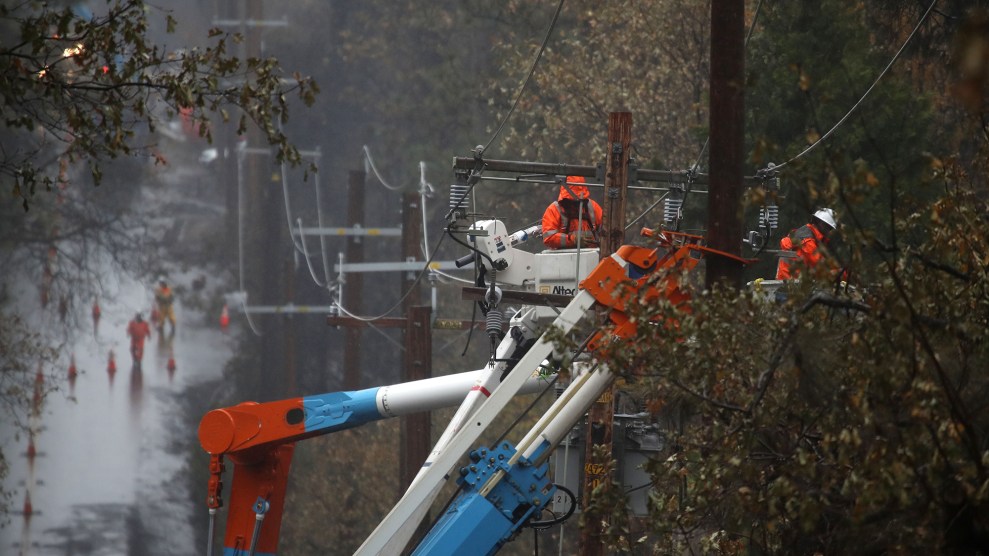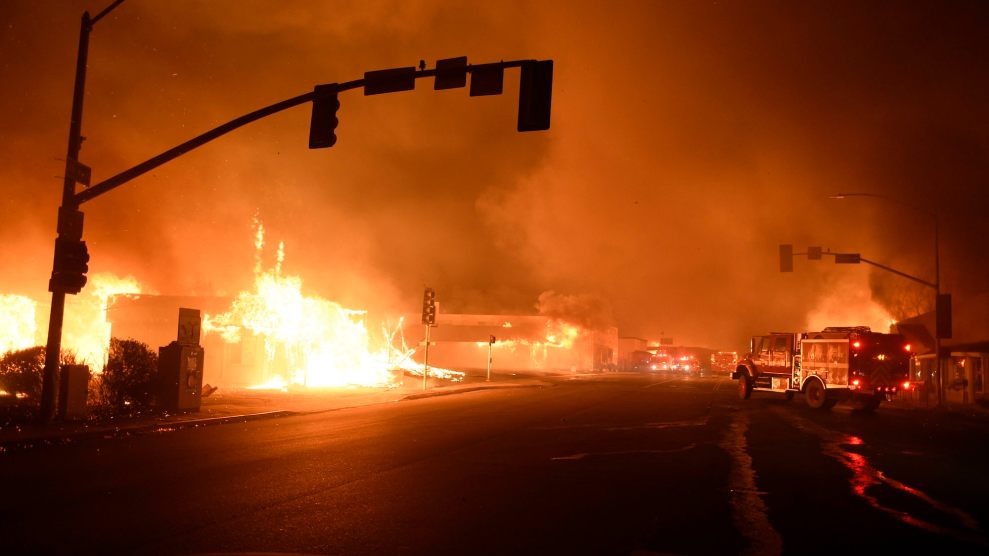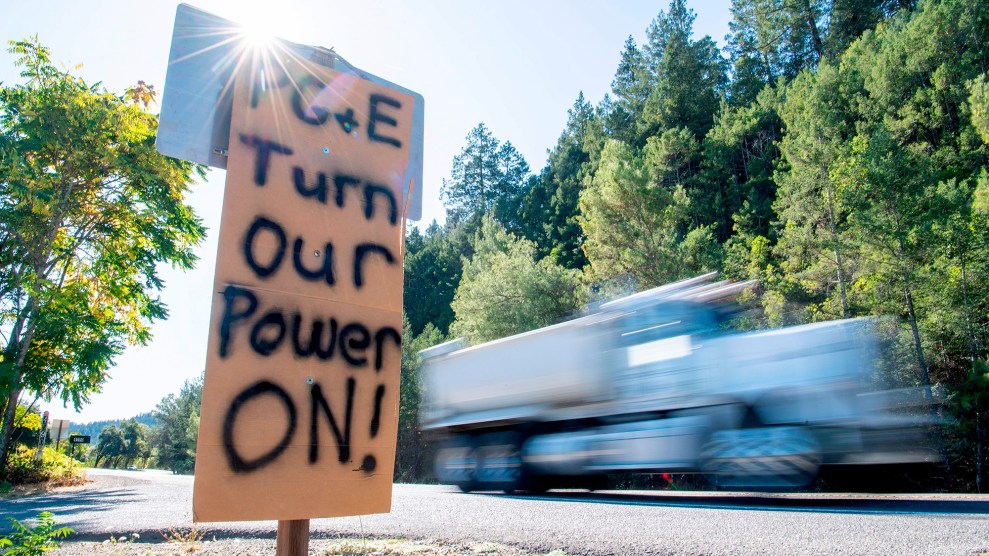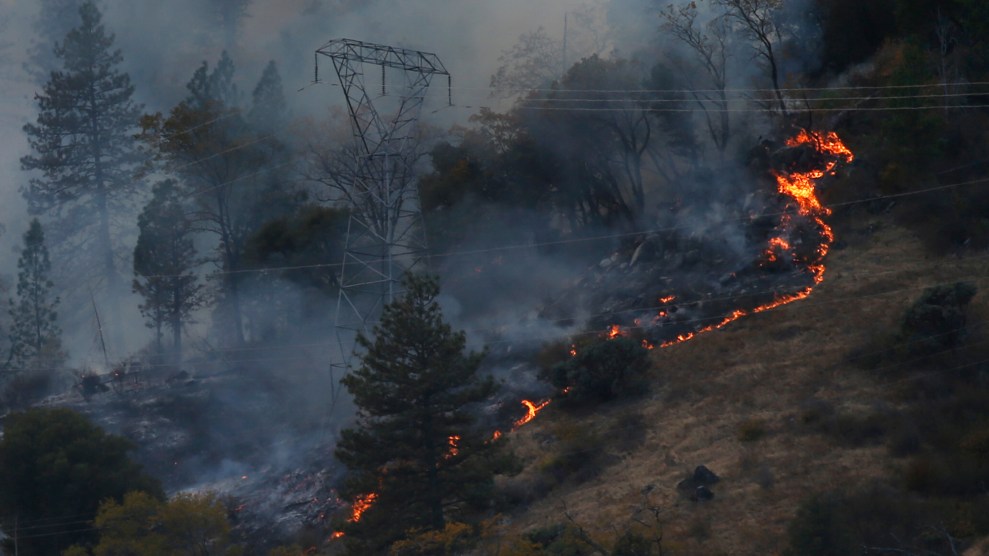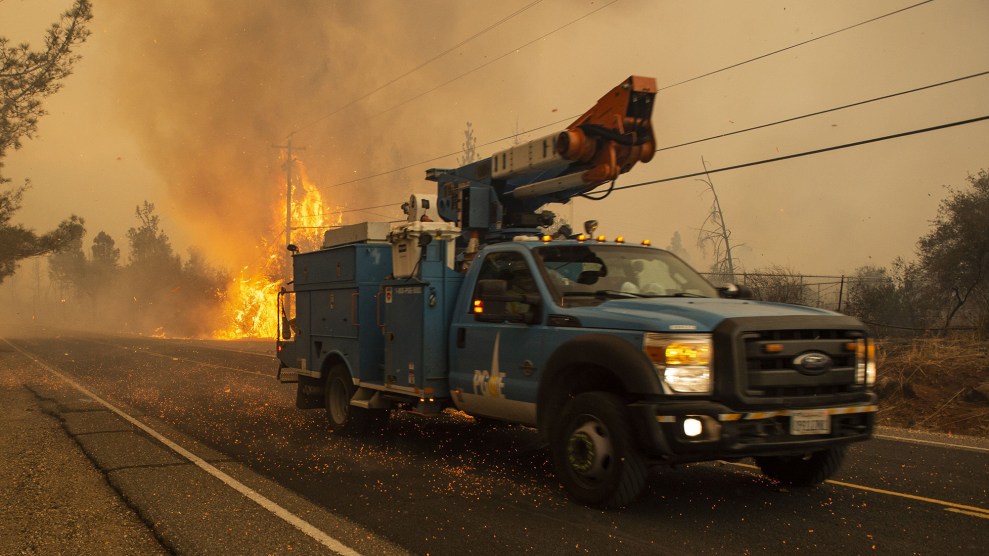
A PG&E truck drives past a hot spot in Paradise, CA, during the 2018 Camp Fire.Hector Amezcua/Sacramento Bee via Zuma Wire
In the wake of PG&E’s decision to cut power to over one million people in California last week, there has been a torrent of frustration, outrage, and suspicion—about who should be held accountable, what their motivations are, and whether there is a way to keep blackouts from becoming the new normal. California Gov. Gavin Newsom notably took an already damaged PG&E to task on Thursday, saying the utility company’s “greed and mismanagement over the course of decades” was to blame for the state’s aging and poorly maintained electric grid, not simply climate change. (Last year’s Camp Fire in Northern California, sparked by a PG&E power line, was the state’s deadliest on record, claiming 86 lives and the town of Paradise; the company has since filed for bankruptcy.) Then this week, state officials called for the company to issue customer rebates, which would cost it millions, and demanded PG&E executives report to an emergency regulatory meeting planned for Friday.
Beyond blame, the dark days have also set Californians searching for new solutions—from a heavier reliance on renewable energy sources to municipal power distribution to microgrids, or local community-operated energy grids that can operate and be controlled autonomously. Still, even these alternatives come with questions about feasibility, equity, and who can afford to benefit from them.
Clean energy and utility policy expert Steven Weissman, for one, thinks these blackouts are bound to continue no matter what we do in the short term—though he argues not all is lost. In a New York Times op-ed Monday, he called the experience of utilities purposefully shutting off power “the new reliability” rather than “the new normal,” but says that if that “means less certainty from traditional grid-based power sources, then it also provides an opportunity beyond the old approach.” Weissman previously served as an administrative law judge at the California Public Utilities Commission, which regulates privately-owned public utilities in the state, before he started the Energy Law program at the University of California, Berkeley.
I recently spoke with Weissman, now a public policy lecturer at the university, about the internal workings of PG&E that led us here, what’s a fair or unfair critique of the utility, and what actually needs to happen to get everyone out of this mess. Below is an edited and condensed version of our conversation.
Was PG&E’s power shutdown really the only option?
Well, when are you asking that question? Because if Tuesday morning you look at the weather forecast, and it looks like there are going to be red flag conditions, and you might have the potential for catastrophic fire, is the shut off the only solution? The answer, then, is probably yes. But if you’re asking more of a long-term question: Did we have to get to this point where we’re having these massive shut offs? I think the answer is mostly no. Is the fact that they had to shut down so much of their system an indication of a failure? I think the answer is yes—clearly, yes. This is a company that has a very challenging system. It covers a tremendous territory. There’s 16 different climate zones. The system has a tremendous amount of complexity that’s kind of grown organically over more than a century. And all of those things are challenges for the company to be able to maintain its system safely.
You would have liked to have seen this company step back decades ago and recognize that all the things I just mentioned were the circumstances it was facing. Imagine how the story would be different if PG&E was now saying, “We’ve been worried about what’s going on now for the last 20 years, and we’ve been addressing the problem in the following comprehensive way. We created this new office, which was designed to look at these problems. We’ve hired the best experts from around the world to come in and work with us. We’ve used state-of-the-art technology.” First of all, maybe we wouldn’t have had all these cut offs. But if we did, at least we could say that this is a company that has done everything it can to wrap its arms around the challenges it faces. But we can’t tell this story.
What do you think of the talking point that’s emerged from PG&E’s critics, including Gov. Gavin Newson, that the company has put profits above people with this shutdown and the decisions leading to it?
It’s an easy thing to say, but it’s really too simplistic. There are two ways that a utility can make money: First is by continuing to invest in new capital projects. The other way is by spending less money than it’s given. What that means is that the regulatory structure gives the utility an incentive to over-invest in facilities and to underspend on operation and maintenance. With hindsight, it’s very easy to look and say the tower that sparked the Camp Fire, if you had put a little more money in operation and maintenance, you could have either strengthened that tower or you could have replaced it, and you didn’t do that. And so therefore, you’re putting profits ahead of safety.
But I think that the problem is much more ingrained in the way this company has developed and continues to operate than it is something as simple as just trying to make more money. Certainly, that incentive is there, and it probably has had an impact over time and resulted in less money being spent on keeping the system in good shape than it should have—maybe a lot less money than it should have. But focusing on that alone does not get to the fundamental underlying problem, which is a company that has not recognized the growing complexity of its system and hasn’t put processes in place to overcome that.
What should PG&E do now to deal with those issues?
I want to see the company openly acknowledge that it doesn’t have the right systems in place. I don’t see that yet. What it seems to be doing is saying, “We have to get a lot better in terms of maintaining our system, and so we’re trimming more trees and we’re doing more inspections.” That’s all great, but those are really fixes that don’t create assurance that operations will continue to be safe in the future. Because if you don’t change the way questions are asked, if you don’t change the accountability of people in different departments, if you don’t add in the right kind of experts, then you’re much more likely in the future to slip back into the same pattern, which is overspending on infrastructure, maybe building more transmission lines than you need, and not spending as much money on maintaining those lines as you should.
Is there a good possibility that we’ll see more of these kinds of extended power shut offs?
Clearly, PG&E is going to try to find ways to fine tune its strategy for invoking these power shut offs, but there’s no reason at this point to believe that they won’t continue to happen. We’re going to continue to see these shut offs into the indefinite future.
Short-term, PG&E can take steps like hardening and maintaining its infrastructure, but what other steps does it need to take to reduce long-term wildfire risk?
Well, I don’t think that’s a short-term fix. It’s going to take many years to take a system of that size and be able to improve the nature of all the equipment—many years and lots of billions of dollars.
But there are other elements here. One is they need to be more aggressive about placing lines in vulnerable areas underground. And part of that involves taking the underground budgets that they have—because they do have some money to spend every year on putting overhead lines underground—and prioritize that money only for safety issues. Traditionally, the money would be spent on putting lines underground at places where there may be some sort of view or it’s a pretty neighborhood or it’s a commercial district that’s trying to attract customers. That’s really not the priority now. The priority has to be safety. And so the question is where are the most vulnerable places? Spend the money there.
Another thing is a much more enthusiastic embrace of microgrids. If microgrids are installed well and involve underground circuits connecting people, then you have a system that can operate more safely year-round. They can help provide power when these outages do occur because you can isolate those microgrids and use the power there. More battery storage strategically located through communities at both the utility side of the meter and the customer side of the meter can be an important part of this. More self-generation can be a good thing as well as long as it’s managed properly.
These are all things that make it less burdensome when these outages do occur, but also might enable more power to be delivered safely. I think there’s going to be a natural response now on the part of a lot of commercial industrial customers and some communities that say, “If we’re going to have these shut offs, then we’re going to have our own backup power.”
That’s fine, but this is an opportunity to make sure that whatever backup power provided is renewable and relies on battery storage rather than using diesel generators. I’ve been in conversations with people at the East Bay Municipal Utility District (EBMUD). When PG&E announced the shut off program, EBMUD went out and acquired a large number of diesel backup generators to put in its pumping stations. That’s a rational short-term response, but now the question is, will EBMUD undertake a program designed to rely on renewables and batteries and eliminate its reliance on diesel generators that are contributing in the long run to the overall problem?
Microgrids and local distribution seem to make a lot of sense, so what’s stopped them from being used more broadly?
The single biggest obstacle is that the utilities are not enthusiastic supporters of microgrids. The way that plays out is that state law gives the utilities exclusive monopoly service territories for being the distribution and transmission companies. There are some exceptions to that, and one exception is something in the law which people call the “over-the-fence rule.” What that says is if I’m generating, let’s say, solar power at my house, I can share it with my next door neighbors on either side of me, but I can’t, for instance, share it with a neighbor across the street, and I can’t share it with more than two other people. Until that provision in the law is changed to say that microgrids are always allowed, I think the utilities are going to continue to be able to basically put the brakes on any microgrid they’re not enthusiastic about.
The city of Berkeley wanted to put a microgrid in when it built this enormous new civic garage downtown. It wanted to put solar on the roof and batteries in the basement and then interconnect all the government buildings in the area so they could have reliable power even when there are other outages or other emergencies, and PG&E wouldn’t get behind it, and it didn’t happen. It’s sort of a schizophrenia here because the legislature has passed some bills that seem to be supportive of having a greater reliance on microgrids. But there’s a lot of resistance, and that resistance is coming from the utilities and probably on top of that the utility workers. Microgrids are supposed to operate in a way where people that are on a microgrid continue to get power off the greater grid unless there’s an outage, but I am suspecting some of the utilities are worried that if communities start out by being able to give themselves their own backup power, maybe eventually they’ll be given the permission to totally disconnect from the greater grid, and utilities do not want to lose customers.
One of the arguments against microgrids is that they are expensive, but with the economic burden brought on by wildfires, power shut downs, and the potential increase in energy costs as a result, do microgrids end up making more financial sense?
It’s hard to make a broad statement about every microgrid, but I’ll say this: I think what is happening now is we’re realizing that there’s a lot more cost involved in having distribution and transmission systems than we thought, both in terms of the losses when you don’t have reliable service, but also the liabilities from the wildfires. If building a line costs you a billion dollars, but eventually could expose you to a $15-billion liability if you cause a wildfire on that line, then maybe that line is more expensive than we thought it was. And if that’s the case, if we really built in the true cost of these things before deciding to have the utilities go build them, maybe other things would start looking better. Maybe rooftop solar, which some economists criticize as being a bad investment because it’s more expensive on a per-watt basis starts looking more cost effective. And maybe batteries don’t seem like such an expensive investment anymore. The whole formula and the whole set of expectations may change.
If cities took control of local power distribution—as San Francisco has been exploring—would that change things at all? [Ed note: PG&E rejected San Francisco’s $2.5 billion offer to buy the company’s local power lines last week.]
It provides an opportunity to change things because when you bring the control down to a local level, then you have a much more direct line of accountability. So if you’ve got San Francisco Public Utilities Commission as an elected board, and they screw up, then you answer to the voters. And because you’re a local official, and you live locally, you run into constituents in the street, and you go to meetings and you talk to people. The community-level values that are placed on something like safety and reliability can become much higher priorities for people running the system because of that local accountability.
Speculation has been popping up—even from some public officials—that basically PG&E could be extending shut offs unnecessarily in order to pressure the legislature into changing the inverse condemnation law, which holds California utilities responsible for wildfire damage caused by their equipment, regardless of negligence. Thoughts?
That’s an interesting one. I want to start this by saying that I think that the utilities have more urgent issues to deal with because regardless of how we want to demonize this company, no one wants to destroy communities, and no one wants to kill people. This is not an evil enterprise. It’s made up of lots of really good decent people. But as a whole the company just doesn’t seem to be as good as the people working there. But nonetheless, here you’re a utility and you’re going to the legislature and saying, “inverse condemnation is a terrible thing, and it shouldn’t apply to us, and if we’re not going to have a guarantee that the customers will reimburse us for any liabilities, then you need to eliminate it, and not have it applied to us.” One of the less-than-top priority, but nonetheless existing messages that comes out of these shut offs is, “Okay, fine. You don’t want to give us that kind of protection. Well, see how you feel about not having power.” And you do wonder about that.

